2017 Activity Report
March Activity Report
March 2018
Global Japan Office Coordinator
AHN Soyon
1. Japanese Language Education
March in South Korea is the entrance ceremony season, the start of the semester, and the time to put plans into action. The demand for the Japanese language in South Korea has risen recently, and so the number of students wanting to learn Japanese is increasing. For these students, I designed a Japanese syllable chart for them to learn in one week. After that week, before they got sick of Japanese, I held off teaching grammar and taught them greetings. That way, they can feel like they can read more, speak more, and thus enjoy Japanese more. I handed out cards with Japanese on one side and Korean on the other, split the students into pairs, and had them play a game where they had to flip over the cards with the syllables they learnt on them so they could learn to read them. One student said that “when I came to class today, I only knew the syllable chart, but now I can read and say 22 different characters, it’s amazing.” It seems they were very happy with their efforts and new ability to form greetings with these characters. After class, the students used their newly learnt greetings, saying ‘thank you, good bye’ to me and ‘good work, see you later’ to their friends.
I don’t want my classes to be a one way street where they just read and write, so I was happy that the students were able to learn together and enjoy Japanese.
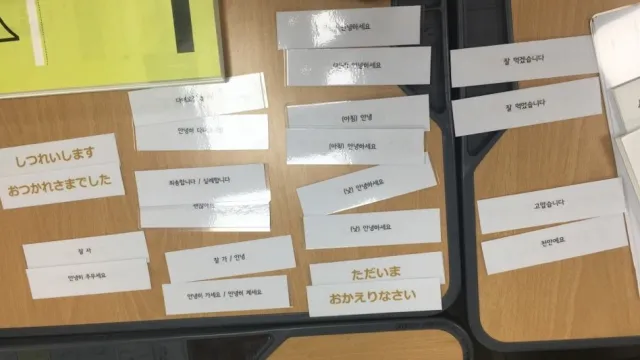
2. Language Exchange
Last month I met with the students who matched up for language exchange. The Korean student invited one more friend, and they are studying as a group of three. The three study together, and ask each other questions when they’re stuck, but sometimes they can’t answer each other’s questions and say things like ‘I didn’t realize how hard my own language is!’ It’s a good chance for them to become more interested in their own language. It seems that the students were troubled with some questions, as they couldn’t answer them without specialist knowledge, but the GJO Seoul Office coordinator just happens to teach both Korean and Japanese, so they were able to help out. It’s difficult for me to always be there when they meet, so I told them to message me anytime through LINE with any questions they are having trouble with. I hope they work hard to meet their goals.
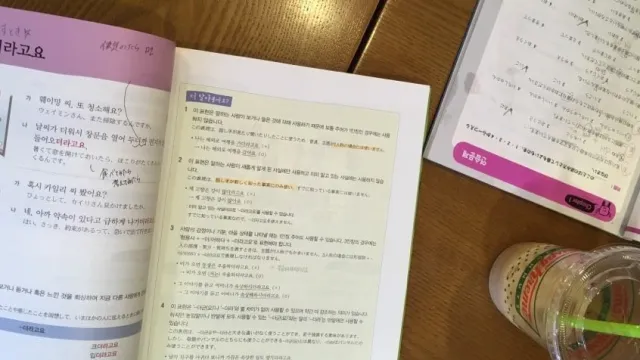
February Activity Report
February 2018
Global Japan Office Coordinator
AHN Soyon
1. Language Exchange
A request for an introduction to the Language Exchange came in from a TUFS exchange student who couldn’t attend the gathering we held last year. They are a top-level student who is very fluent in Korean. Among the Korean students visiting the GJO, there was one student who said ‘I became interested in Japanese after I took it as an elective. I’m only a beginner but I want to improve and be able to speak freely in Japanese. Please help me.’ Because of this, I introduced these two students to each other.
After they exchanged contacts, they began talking on KakaoTalk and going out for tea, through which they talked about their interests and helped each other study. The two students said they were very grateful to me for introducing them.
2. Social Networking Service (SNS)
From introducing the Language Exchange, I realized that there are more Japanese exchange students and Korean students who want to make friends through the Language Exchange than I thought, but these students also find it rather difficult to do so. There are also students who want help with things outside of their language studies, such as troubles in their daily lives on exchange. I’ve only just started the GJO SNS, but I want to use it to spread information about the GJO to help both Korean and Japanese students.
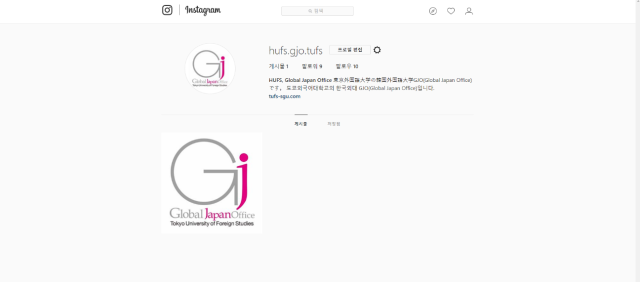
January Activity Report
January 2018
Global Japan Office Coordinator
AHN Soyon
Social Networking Service Established
Until last year, we planned and promoted events and Japanese education-related activities through student connections and the cooperation of the TUFS Student Mobility Center, the HUFS Japanese Department Student Council, and Japanese organizations in South Korea. I always thought, since South Korea has such a good IT environment, we should appeal to students seeking support through social networking services (SNS). However, since I don’t really use SNS, I haven’t been able to carry through with this plan. Many students didn’t hear about the cultural exchange meeting, which was held last year, and asked to be informed when the date for the next one was decided. Because of this, I decided to create a social media account for the GJO Seoul Office so that students interested in Japan and students coming on exchange from Japan can learn more about the office, and so that the office can support these students in ways that benefit them.
There are many types of SNS, but I decided to choose which platform to use based on the following four criteria. 1. The platform most popular with university students, 2. The platform students used most when searching for information, 3. A platform which can convey information clearly, 4. A platform which can be used by beginners like me. As a result, I chose Instagram as our SNS platform. Thankfully, some students who are skilled at using Instagram showed me how to use it, and I learnt how to use it to the best of my abilities without too much assistance. Finally, I learnt how to make a business profile and opened the account.
I plan to start posting information on Japan and the exchange student lifestyle in South Korea from March, to coincide with the new semester. In the end I want to make this account a source of information from the GJO Seoul Office that contributes to Japan-Korea relations between university students.
December Activity Report
December 2017
Global Japan Office Coordinator
AHN Soyon
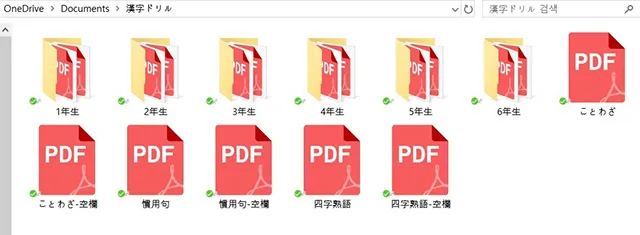
At most Korean universities, the final exams end by the third week of December at the latest, and it is winter vacation until the end of February next year (the Korean semester starts from March). Usually students make plans for the vacation before it actually starts, but since the Korean New Year is celebrated during the winter vacation, they also plan for New Year’s. Every year there who a number of students who plan to study Japanese during the winter break. This includes students who have already been studying Japanese before, but plan to redouble their efforts, as well as students who are not majoring in Japanese, but have decided to study Japanese for their future.
The largest obstacle to learning Japanese for Korean students is learning kanji (Chinese characters used to write Japanese), and there were a number of requests from beginner-level students that they be given the opportunity during the winter break to learn lots of kanji. Many students ultimately quit studying Japanese because they cannot overcome the hurdle of learning kanji; this is especially true for beginners. I thought about how I could help the students continue their studies and efficiently learn Kanji. Believing that there is no better way to memorize than through repetition, and that there is a need for students to understand the concept of onyomi (the “Chinese” reading of a character) and kunyomi (the “Japanese” reading of a character), and to memorize the onyomi and kunyomi of each letter, I decided to use the “Kanji Drills” used by Japanese elementary school students. Thankfully, there were Kanji Drills available on the Internet for free. It was a Japanese website with everything written in Japanese, so I downloaded it onto the cloud and shared the URL.
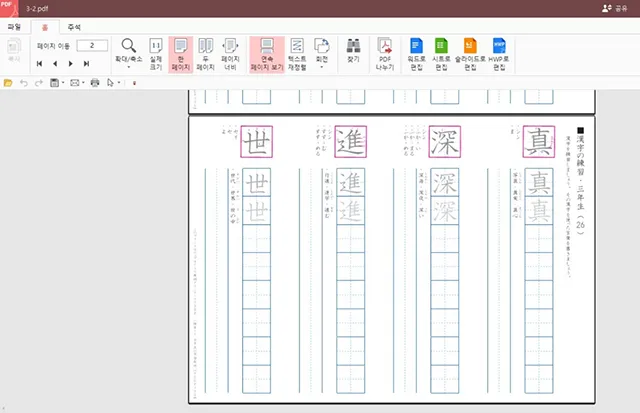
However, all the files were in Japanese and students did not understand how to use them. Additionally, since students had gone home for the winter and our schedules did not match, I decided to give a tutorial via video conference, during which I explained the files. I taught the concept of kunyomi and onyomi, that Kunyomi are written in hiragana and that onyomi are written in Katakana, and taught them how to study with the Kanji Drills. Since it is good exercise to look up the kunyomi definition of the characters in Korean, I decided it was best that students do that themselves. Since they belong to a generation used to online classes, they had no problem with the video conference and students were able to ask questions on the spot and I was able to make sure that students were doing it correctly and it went very well.
However all students agreed that since Korean kanji only have one kunyomi reading and one onyomi reading per character, it was difficult that Japanese kanji can have multiple kunyomi and onyomi.
By starting with the elementary school Kanji Drills, students would learn how to memorize kanji, get a basic knowledge of kanji and then move on to the intermediate level. If they had any questions or if there was anything they were unsure about, I decided I would answer via video conference. I hope that they overcome their difficulties with kanji.
November Activity Report
November 2017
Global Japan Office Coordinator
AHN Soyon
1. Organizing Language Exchange
We had the cultural exchange meeting last month. There were international students who couldn’t participate because of scheduling conflicts, as well as Korean students in the Japanese department who couldn’t attend due to limits on the number of participants. This led me to wonder if there was anything that could be done for such students. It occurred to me that we might do small language exchange meetings in groups of two or more. I made the arrangements to talk with the person responsible for the cultural exchange meetings at the Japanese faculty. It is in November that a new Student Committee is formed, so we agreed we would decide on the actual dates and participants after November, when the Student Committee election would be over.
2. Discussion regarding language training
Interest in Japan dropped after the Tohoku earthquake of 2011, but recently there has been a renewal in interest in Japan. One of the reasons is that Korean media has portrayed Japan as a seller’s market in terms of employment opportunities, contrasting with Korea, where it is increasingly difficult to get a job. This has led many Koreans to look to Japan for a job. This is probably the reason why we have received an increased number of requests for consultations about language training. We have introduced programs such as the short stay programs at TUFS, and we advised Korean students to choose schools based on the university’s history, curriculum, trustworthiness, and name-recognition. Most of the students ask for consultations with job opportunities in mind, and many ask about ways in which they could improve their Japanese in a short time so that they could work in Japan.
3. The Japanese Language Proficiency Test
The Japanese Language Proficiency Test is held in Korea on the 3rd of December. One of the necessary conditions for Korean students to work in Japanese corporations is to have passed the JLPT, so in preparation for the test in November they review what they had learned so far, and see how they perform in mock exams. The JLPT is only held twice a year, and since failing the exam means that students have to wait another 6 months to try again, many students feel as if they have their backs to the wall. In the last month prior to the test, it is typical to have a number of students come for consultation about study method, as well as for students to come who are experiencing anxiety over whether they will be able to pass. I tell them that they don’t have to aim for perfection, since the passing grade is 70%, and that they should do as many mock exams as possible. I hope all of their efforts pay off.
October Activity Report
October 2017
Global Japan Office Coordinator
AHN Soyon
On the 26th of October, the GJO held the long-awaited cultural exchange mixer with the HUFS Japanese Department Student Council (referred to below as ‘Student Council’). The GJO invited exchange students from TUFS and other universities, and the Student Council gathered the Korean students. There were many more Korean students wanting to participate than expected, but unfortunately there was not enough room for everyone, and so only 20 students were able to participate. There were ten Japanese exchange students hailing from TUFS, Osaka University, and Fukushima University, making a total of 30 students at this year’s mixer.
The Student Council prepared the venue, drinks, and snacks. The mixer started with the students gathering in a lecture theater at HUFS, and breaking into five groups to do self-introductions. The original plan was to have the groups rotate every 30 minutes so that all the students could meet each other, but two hours was not long enough for this, and the students were enjoying the groups they were in, so we left the groups as they were for the remainder of the mixer. During the mixer, the students exchanged email addresses and SNS details so they could continue meeting outside the mixer.
After this, we moved on to dinner portion of the mixer. The dinner was held at the samgyeopsal restaurant in front of HUFS, at which the students ate in the groups they had formed, and then the mixer came to an end.
The Student Council has made specific plans so that the relationships formed at the mixer don’t end at the mixer. For the groups that continue meeting and go on some sort of excursion together outside of the mixer, the Student Council has offered a prize of ₩30,000 (roughly \3000).
While it is a shame that not all of the students who applied could participate, there were more Korean students who were not chosen than there were participants, many of which have expressed their desire to participate in the next mixer, and the Japanese students also seemed happy to be able to meet Korean students, so we are currently discussing the possibility of having more than one mixer a year, and making the mixers a regular occurrence.
This mixer was a good opportunity for Japanese and Korean students to meet and better understand each other, and I hope it was a fun event that becomes a good memory for the students.
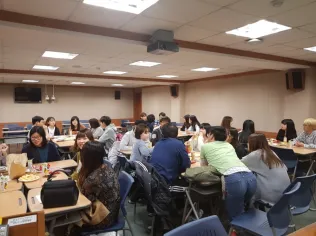
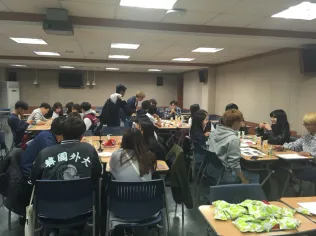
The Mixer
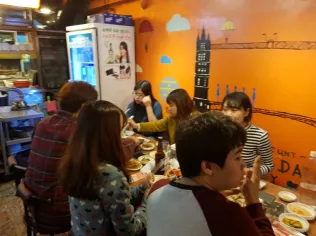
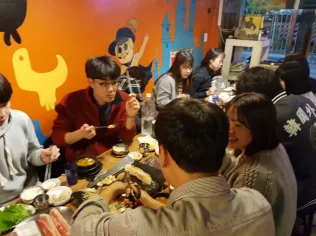
The Dinner
September Activity Report
September 2017
Global Japan Office Coordinator
AHN Soyon
Korea Japan Festival
The Korea Japan Festival (http://omatsuri.kr/) was held again this year at COEX in Seoul. This event is considered a big event at which Koreans can experience Japan through all the five senses, as many Japanese companies and municipalities participate in this event, offering new information on Japan, and opportunities to experience Japanese culture to Koreans.
The booths and events were more or less the same as last year, but it seemed to be fascinating for the students who had never been before. Aside from Koreans, many Japanese people living in Korea attended, so it was a very lively event.
The booths that offered kimono dress-ups, toy trials, new technology trials, and ‘photo-zones’ had the longest lines, and rather long waiting times. So much so that even if you set aside five to six hours for the event, you would not be able to try everything.
With an abundance of performances on offer, I chose the ones I wanted to see the most and headed to the stage at those times. In addition to traditional Japanese performances that of course cannot usually be seen in Korea, I was also able to see performances by Korean teams that one generally cannot see for free.
There were also many booths selling Japanese food, so I walked around the festival while snacking, but I also noticed that many booths sold out and had to close just after lunch.
General Impressions
- One day is not enough. Even though I came in the morning, I didn’t have time to look at everything. I wish they’d open it for one more day.
- I’ve always had an interest in Japanese culture, but I thought that I could only experience it indirectly if I didn’t actually go there. However, at the festival I was able to wear a kimono and take pictures in Japanese character masks, so I had a lot of fun.
- The event wasn’t as good as I expected. There were too many company advertisements. If they sold more actual products it might have been better.
- I’m interested in cosplay, so coming to the festival and seeing all the people in costumes was almost like going to Harajuku.
- The government booths were focused on tourism, so I couldn’t actually get much information on the regions in general, so that was a shame.
- I printed a picture from my phone with Japan’s latest printing technology, it was a weird but fun experience. I now have a calendar with a picture of my face on it to remember the event by.
- The Japanese volunteers spoke Korean really well, they really made an impression on me. I was surprised considering that it’s a foreign language for them.
- My girlfriend forced me to come, so I came not expecting much, but after seeing Prime Minister Nak-yeon Lee give the congratulatory address, I realized the scale of this event. I was also happy that I got to take a photo with my girlfriend wearing a kimono.
- I was able to see with my own eyes that Japan continues to succeed in making anime and character-related goods. I really wanted to do the ‘plastic model trial,’ but the line was so long I couldn’t. I was surprised by how many cosplayers there are in South Korea.
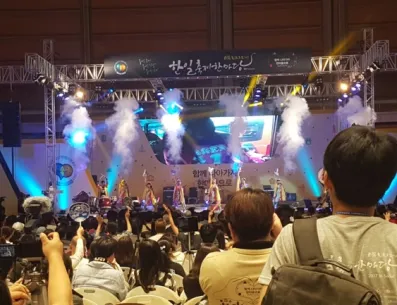
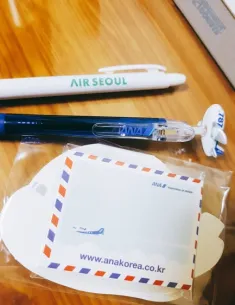
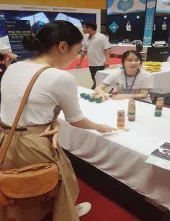
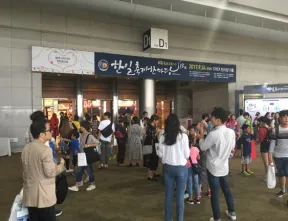
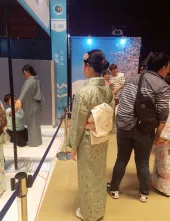
August Activity Report
August 2017
Global Japan Office Coordinator
AHN Soyon
1. Preparation for Cultural Exchange Mixer
We are currently having preparatory meetings concerning the Japan-Korea Cultural Exchange Mixer with the HUFS Japanese Department Student Council. We decided that GJO would recruit Japanese participants, and the Student Council would recruit Korean participants, so I sent an email to the Japanese students on exchange in Korea. There are many students wanting to attend, so the mixer will be bigger than last year, and I hope this makes it an event where students can make many new friends.
The Student Council is working hard to arrange the time and place so the mixer can be held in October.
2. The Korean Japan Information and Culture Institute’s ‘Summer 2017 Introduction to Japanese Culture Exhibition’ Special Performance Viewing
The Japanese Information and Culture Institute’s ‘Summer 2017 Introduction to Japanese Culture Exhibition’ offers many different cultural experience programs, and while most of them are aimed at children, there are two performance events that adults can enjoy, so I booked via email and took the students to see them.
The first performance was a Japanese-style street performance by performance unit Pao-pao Dou and Taiheiyou, and was a performance that both the audience and performers could enjoy together. The performance was mainly designed around music, making it an enjoyable performance whether you understood the language or not. Pao-pao Dou’s performance focused on theme songs from Japanese animations that are also famous in South Korea, and original soundtracks from famous films, and for their finale they played a Korean song, at which the audience stood up, clapped and sang along.
Taiheiyou performed a balancing act. The audience watched anxiously as he balanced on various objects, and cheered and clapped when he succeeded, it was as if every member of the audience joined together and enjoyed the performance as one.
The next performance was titled ‘Scenery of Japan Concert’ and consisted of shakuhachi, koto, and shamisen performances, instruments you cannot often experience in South Korea. The Korean Japan Information and Culture Institute has actually started offering koto lessons, and the renowned musician Seiei Tomimoto is in South Korea just to teach this class, so there was also a corner with a demonstration done by her students. It may have been difficult to understand the music just by reading the song titles, but commentary from the emcee allowed the audience to understand and imagine the scenery of the music while listening.
It is a shame that the exhibition coincided with the summer vacation, so I couldn’t go with a lot of students, but it was such a good experience so I would like to take more students next year.
*Students Thoughts on the Performances
‘I’ve seen Pao-pao Dou and other street performances at theme parks before, but the clothing and props felt very Japanese, so it was different from the performances I’ve seen before.’
‘That’s the first I’ve heard of koto lessons. If I have the opportunity I’d love to go. There is also a traditional Korean instrument similar to koto (geomungo). It made me think about how, from long ago, Japan and Korea have had so many similarities.’
‘The melodies of the traditional music are similar to Korean music, but at the same time different. The boundary between differences and similarities in culture is really interesting.’
‘I only had time to see Pao-pao Dou and the street performance, but next time I would really like to watch the koto performance too. The unique serious and powerful acting was uniquely Japanese, and was very memorable for me.’
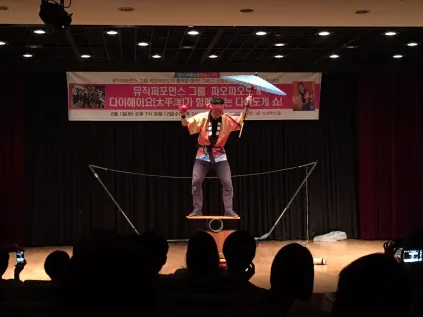
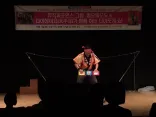
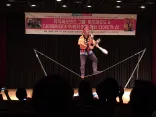
Taiheiyou’s Street Performance Show
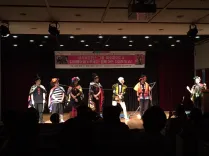
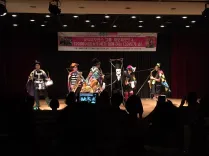
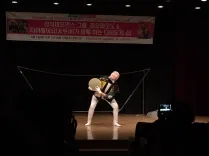
Music Performance Unit Pao-Pao Dou
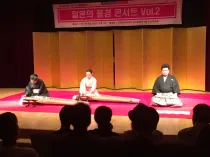
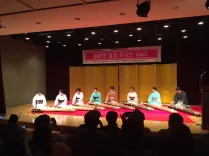
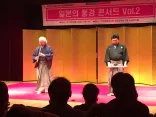
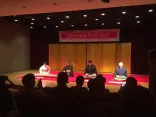
Scenery of Japan Concert
July Activity Report
July 2017
Global Japan Office Coordinator
AHN Soyon
1. Summer 2017 Introduction to Japanese Culture Exhibition: ‘Japanese Toys and How to Play with them’
Continuing on from last year, the ‘Japanese Toys and How to Play with them’ exhibition, held by the Embassy of Japan in Korea’s cultural center, was held from the 24th of July until the 5th of August. This exhibition received a lot of attention last year, so this year we once again advertised it over social media. We also had screenings of Japanese films from 2:30pm, meaning guests could enjoy a film for free while enjoying the exhibition.
While the exhibition is essentially the same as last year’s, an introduction to Japanese toys from Edo period to present day, the number of toys and games you can physically try out were increased. This year’s games were very popular, and included ‘goldfish scooping,’ bamboo decorating, ‘yo-yo fishing,’ yukata and happi dress up, masks, origami, and drawing. In particular the yukata and happi dress up was a hit, getting many ‘likes,’ similar to last year, from students using social media. The toys you could try out included kendama, ohajiki (Japanese tiddlywinks), quoits, spinning tops, daruma otoshi, bamboo-copter, otedama (Japanese jacks), and menko (Japanese card game). In Korea we have games like menko and ohajiki, and while the appearance of the toys are slightly different, the rules are more or less the same, and many students could be heard saying ‘wow there’s lots of games similar to Korean ones, I wonder what country they actually originated from.’ Illustrations from Masatoshi Ichiyama’s ‘Children of the Showa Period,’ were on display, which made it possible to imagine what children playing these games in those days looked like. The fact that Korean toys and games from that period are very similar shows how much Korea was influenced by Japan.
Because of this exhibition, students and other guests could experience a variety of foreign culture in a carefree manner without leaving Korea, so we are very blessed to have this kind of environment. I want to use the summer vacation next year to tell many more students about this exhibition.
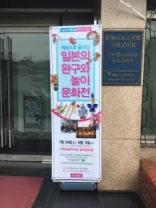
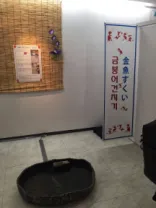
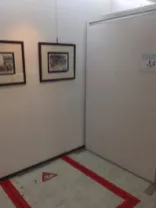
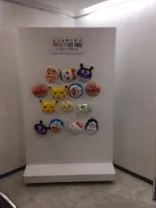
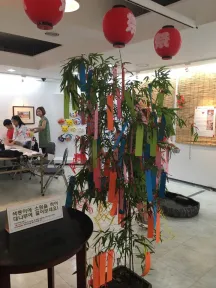
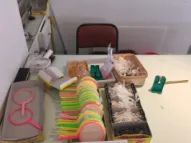
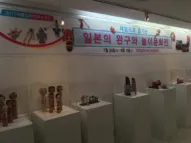
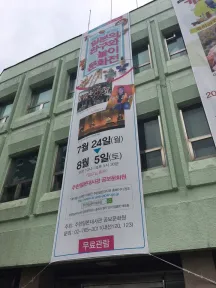
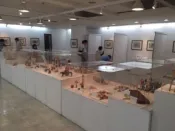

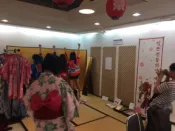
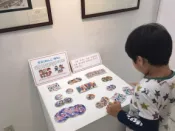
2. Japan-Korea Cultural Exchange Mixer
Last year, we held a mixer for Japanese exchange students and Korean university students, which proved a great success. Last month I met with Jae Woo Park, president of the student council, to discuss organizing this mixer together with the HUFS Japanese Department Student Council. Since the organizer of the mixer (In Soo Lee) had already been decided, we met and discussed good points and points needing improvement based on mixers from previous years. Based on problems from previous years, we decided to aim at making the cultural exchange a more continuous experience, as opposed to just a one-off event. So we came up with a rough plan to hold a few get-togethers in the middle of September, with the first being a mixer, and the second and third being events where students can directly experience the respective cultures. We only have about 90 days before then, so we decided to meet again soon to discuss the fine details.
June Activity Report
June 2017
Global Japan Office Coordinator
AHN Soyon
1. In the month before last (April), the Nagasaki head of the Nagasaki-Seoul Office sent us the participation guidelines for the ‘Japan-Korea Future Classroom’ that we discussed when he visited the Seoul office. As a recommendation from a professor is required, I asked Professor Yong Koo Park, and began taking applications within the Japanese Department.
This event will take place at either Busan or Nagasaki (Tsushima Island) for six days and five nights, and will:
①Involve the exchanging of ideas and discussion of ‘similarities in the culture/customs of each country,’ ‘thoughts on the international relations plans between Japan and Korea,’ and ‘the Japan-Korea international relations plans used in the Joseon mission to Japan’ in this order by Japanese and Korean students.
②Involve the discussion of the theme, ‘The Future of Japan, China, and Korea – ideal approaches to international relations’ between Japanese, Chinese, and Korean students.
For those who are about to participate in activities in East Asia, Nagasaki Prefecture will pay for everything except airfare and meals, so there will be little financial burden, making for a rewarding event.
Unfortunately, because this was the first time applications were taken at Hankuk University of Foreign Studies, not many students knew about this opportunity, and so there were fewer applications than expected. I hope that, from next year, this can become an opportunity for more students than this year to consider East-Asian relations from multiple sides.
2. In June the final examinations for the semester will be held, and on July 2nd the biannual Japanese Language Proficiency Examination will be held. Just like last June, students seem very busy studying for each test. While I normally get one question a week from a student, near the examination period I get so many questions that I had to tell students to ask me through LINE. This way I could take photos of passages from textbooks that will help students solve their problems, and send them immediately. Learning a foreign language is, of course, no walk in the park, but for Koreans in particular, it is difficult to understand where words end and begin in Japanese. This is because in Korean you leave spaces between each part of speech when writing, and read based on that, but when writing Japanese no spaces are used, so it is difficult for Koreans to tell where one word ends and another begins. I hope the students get good grades for their efforts.
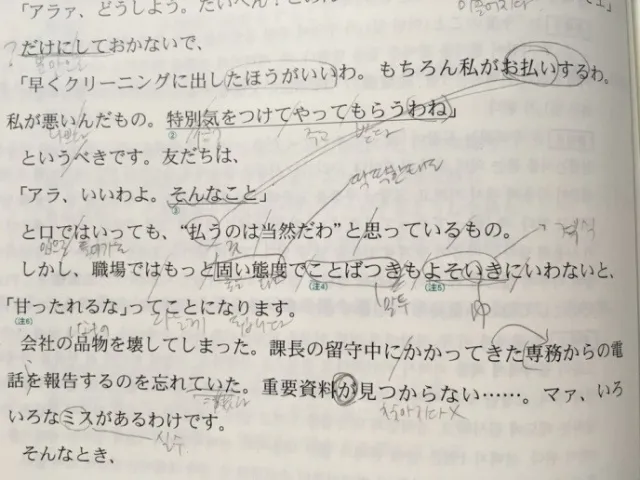
May Activity Report
May 2017
Global Japan Office Coordinator
AHN Soyon
With Korean, one only has to memorise the 14 consonants and 10 vowels of Hangul to be able to write it, but with Japanese one has to memorise katakana, hiragana and kanji. That’s why learners of Japanese have to keep memorising more kanji throughout their study. In Korean, there are no words that are written with kanji, so there are not a few students of Japanese who give up under the burden of learning them.
Every month, there are students who come to the Japanese Learners’ Circle to ask questions about Japanese. There are some new students who have just joined the circle who feel like giving up Japanese due to the pressure of memorising kanji, and so they wanted know if there was a good method of learning them.
The card game that we tried after the Japanese language aptitude test was well-received, so I suggested playing it again. Kanji is a stressful learning point for beginners, so I prepared hiragana cards (since there were some students who hadn’t mastered katakana yet) on the foundational themes of ‘location’ and ‘being’. I didn’t want their eyes to be drawn to Hangul, so as much as possible I used pictures instead.
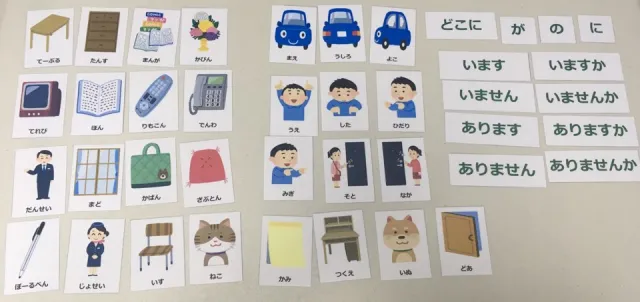
We formed groups of three so the students could work together.
1. Show the kana cards. Try to remember any vocabulary you don’t know.
2. Show the ‘ある’ and ‘いる’ cards (in Korean, ‘ある’ and ‘いる’ both translate to ‘있다’, so practice is necessary to distinguish between them)
3. Separate the cards that go with ‘ある’ and ‘いる’
4. Show the location cards. Memorise them to a rhythm with gestures.
5. Show the verb cards. Pay attention to usages that differ from Korean.
6. Show the pictures.
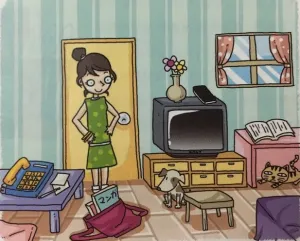
7. Using the cards shown, make sentences explaining the positions of objects in the picture (there are many ways to explain the position of each thing, so you can make quite a few sentences).
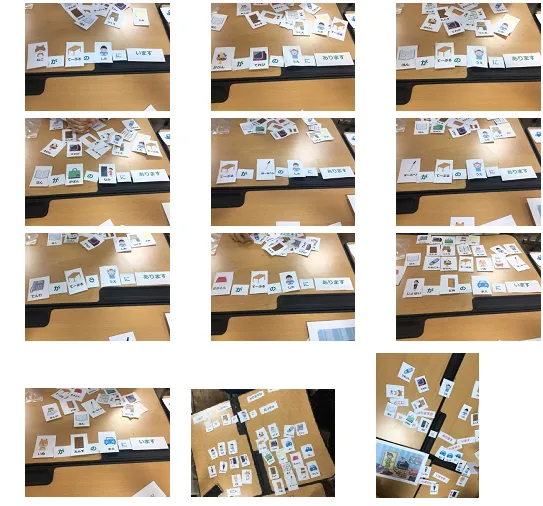
8. Try forming the sentences you made using the cards.
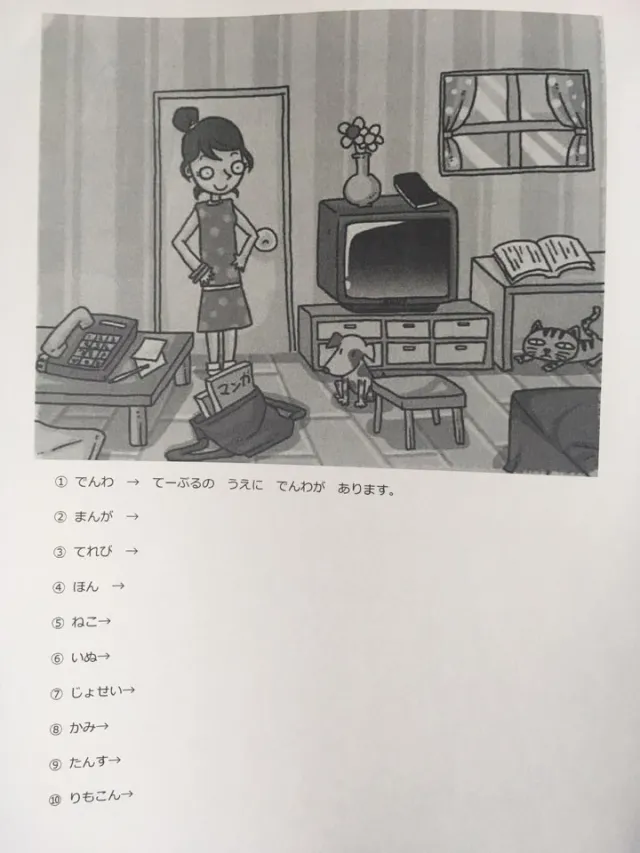
The students usually study through writing texts, which can get boring, so they were pleased to be able to study in a fun, stress-free way, even with just hiragana and no Hangul, by using cards with cute pictures. Since from here on the students will be trying their best to memorise katakana and kanji, I said I’d like to try vs. team games. As a fun way to study, I suggested a method whereby everyone in the club makes cards, memorises the vocabulary and uses the cards to practice.
There is a saying in Korea, “starting is half the battle”. When they started studying Japanese, they all must have had determination, so there’s no reason for them to stop at kanji. Since they took the trouble to start studying, I want them to at least achieve the target they set for themselves at the beginning.
April Activity Report
April 2017
Global Japan Office Coordinator
AHN Soyon
1. When I went to see the different prefectural offices in Seoul not long ago, the head of the Nagasaki office and I decided to contact each other if there was anything that we could collaborate on. Recently, the head asked to come and see the GJO Seoul office, so I invited them to visit and have an interview with the head of the Japanese language department at Hankuk University of Foreign Studies, Prof. Pak Yong. Among the events that the Nagasaki Prefecture office works on is a big event aimed at students held every year in summer, which is a programme where Korean students are invited to Japan spend around 3-4 days doing activities with Japanese students. In general, students can’t participate unless they are recommended by their teachers, so the cooperation of the head teacher is also a necessity, and the GJO would be able to contribute when it comes to taking applicants. In particular, finding a way of getting applications from a wide range of students is something that they have been troubling over. We decided on them to telling us if there are any events where lots of students can experience Japan other than this programme. I think that if the Japanese language department, the GJO, and the Seoul Nagasaki Prefecture office collaborate together, we can have an even greater exchange of information and have even more students experience Japan, making lots of happy memories around Japan.
2. Last year, there was a university student cultural exchange event for Japanese international students in Korea and Korean students. Since the level of satisfaction was high on both sides, I am thinking of holding another this year, and as I was troubling over how to get applications from Korean students, I was introduced to the Japanese language university student council head by a friend. The student council holds cultural exchanges once a year in the second term, and apparently they are having trouble finding a channel for those. We agreed that it would be good if the student council and the GJO could collaborate to hold regular cultural exchanges aside from the one held yearly. However, the student council head can’t decide on event plans independently, so we decided to talk about this more in detail from here on.
